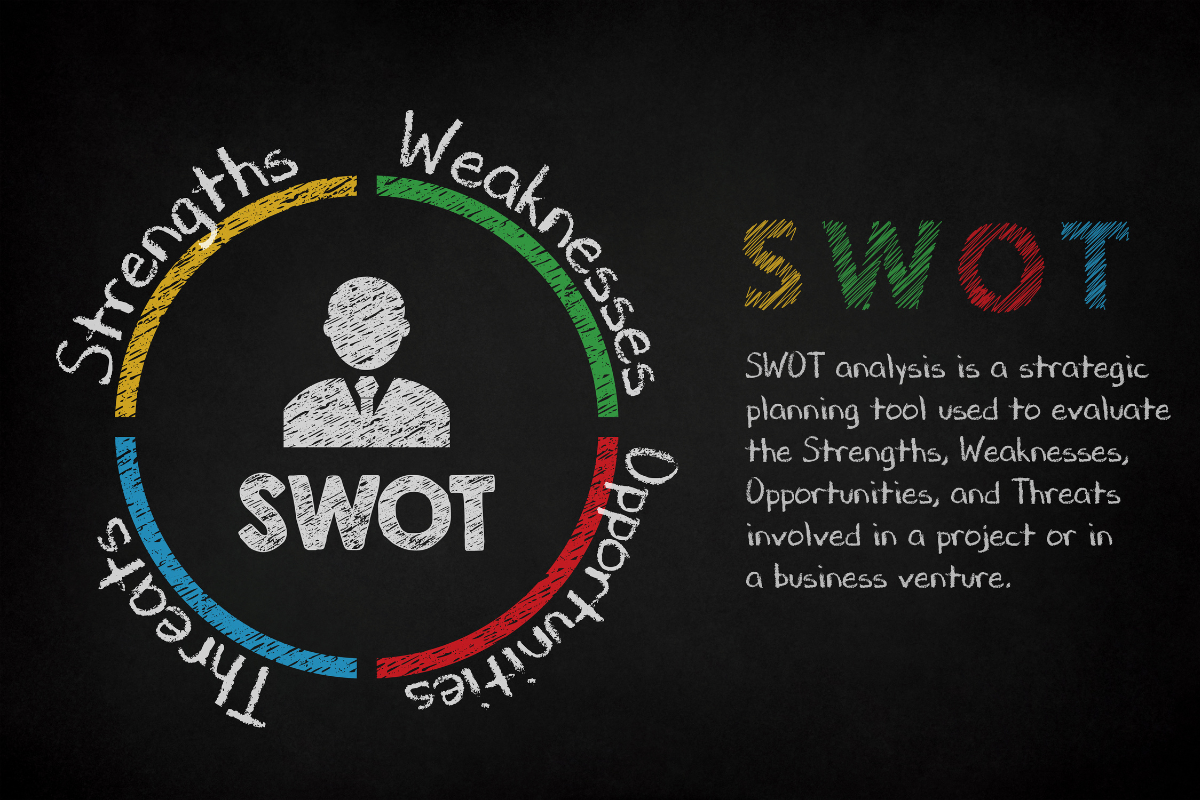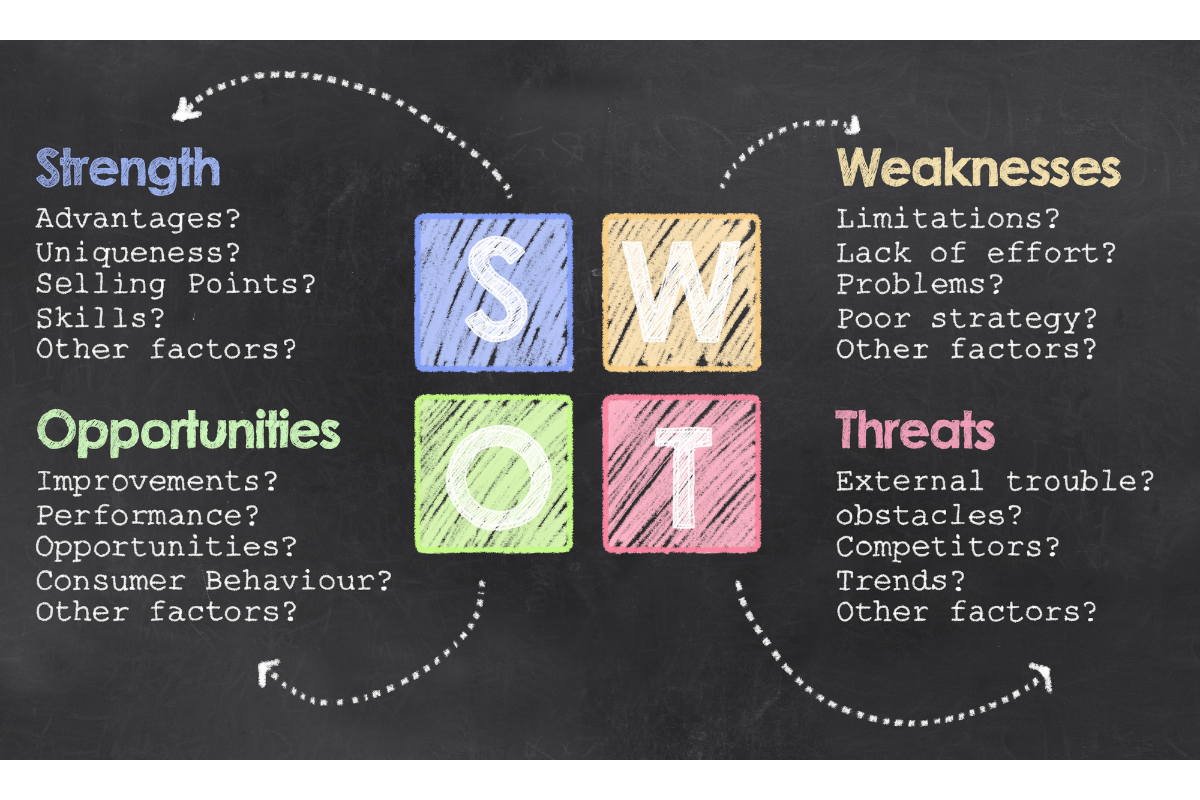Are you ready to unlock the full potential of your business? Then take advantage of this SWOT analysis guide as we delve into the art of identifying and leveraging your strengths, while strategically seizing every opportunity that comes your way.
In the ever-evolving landscape of business strategy, one powerful tool stands out like a beacon of clarity amidst uncertainty: the SWOT analysis. Imagine navigating your entrepreneurial journey equipped with a comprehensive SWOT analysis guide, a roadmap that unveils the hidden treasures within your organization.
So, don’t let your strengths go unnoticed or opportunities slip away. Join us on this journey and start making your mark in the business world today!
Navigate The Business Battlefield!
Understanding SWOT Analysis Fundamentals
SWOT analysis, which stands for Strengths, Weaknesses, Opportunities, and Threats, is a strategic planning tool used to identify and understand the internal and external factors that can impact a business or project. When conducting a SWOT analysis, it is essential to assess the strengths and weaknesses of the organization internally, while also considering the opportunities and threats present in the external environment.
Strengths refer to the positive attributes and resources within the organization that give it a competitive edge. Weaknesses, on the other hand, are areas that need improvement or pose challenges. By identifying these factors, businesses can leverage their strengths and work on overcoming weaknesses.
Furthermore, analyzing opportunities helps businesses capitalize on potential areas for growth and expansion. Understanding threats enables organizations to anticipate challenges and risks that may hinder their success.
A comprehensive SWOT analysis guide is crucial for developing effective strategies, making informed decisions, and staying ahead in today’s competitive business landscape.
Identifying And Maximizing Strengths

When it comes to SWOT analysis, identifying and maximizing strengths is a pivotal step toward achieving business success. By recognizing your strengths, you can leverage them effectively to gain a competitive edge.
- Identify Strengths through SWOT Analysis: Start by analyzing your business’s internal strengths, such as unique capabilities, resources, and competitive advantages. Look at what sets your business apart from competitors.
- Utilize Customer Feedback: Listen to your customers to identify strengths that resonate with them. Positive feedback on product quality, customer service, or brand reputation can highlight key strengths to maximize.
- Employee Skills and Expertise: Assess the skills and expertise of your team members. Identify areas where your employees excel and leverage these strengths to drive business growth.
- Market Positioning: Evaluate how your business is positioned in the market. Identify strengths in your market share, brand recognition, or customer loyalty to capitalize on opportunities and stay ahead of competitors.
- Continuous Improvement: Regularly review and update your strengths based on market trends, customer preferences, and industry developments. Adapt and optimize your strengths to maximize business performance.
In the realm of SWOT analysis, unlocking the true potential of your strengths can lead to remarkable growth and opportunities. By maximizing these strengths, you empower your business to thrive and excel in an ever-evolving marketplace.
Analyzing And Overcoming Weaknesses
In the realm of SWOT analysis, analyzing and overcoming weaknesses is a critical component of strategic decision-making. Understanding and addressing weaknesses can be the catalyst for improvement and progress.
- Identify Weaknesses:
- In SWOT analysis, weaknesses are internal factors that hinder business growth.
- Examples include poor brand reputation, outdated technology, or lack of skilled employees.
- Evaluate Impact:
- Assess how each weakness affects the business’s overall performance.
- Understanding the significance helps prioritize areas for improvement.
- Develop Strategies:
- Create actionable plans to address and mitigate weaknesses.
- Strategies may involve training programs, technology upgrades, or process optimization.
- Monitor Progress:
- Regularly review the effectiveness of implemented strategies.
- Adjust approaches if weaknesses persist or new ones emerge.
- Turn Weaknesses Into Strengths:
- Utilize weaknesses as opportunities for growth and innovation.
- Transforming weaknesses can lead to competitive advantages and business development.
- Seek External Perspectives:
- Obtain feedback from stakeholders or industry experts on identified weaknesses.
- External insights can provide fresh perspectives and solutions.
- Continuous Improvement:
- SWOT analysis is an iterative process.
- Embrace weaknesses as learning opportunities for continuous improvement.
By meticulously analyzing and actively overcoming weaknesses identified through SWOT analysis, businesses can fortify their foundation, mitigate risks, and pave the way for sustainable growth and success.
Recognizing And Seizing Opportunities

Within the framework of SWOT analysis, recognizing and seizing opportunities is essential for maximizing business potential. By conducting competitive analysis for small businesses, identifying opportunities, and capitalizing on them, businesses can gain a competitive edge and fuel growth.. Here’s a guide to help you make the most of this strategic planning tool:
- Identify Opportunities: Look for external factors that your business can leverage to grow and succeed.
- Market Trends: Analyze market trends to spot opportunities for expansion or diversification.
- Competitor Analysis: Assess competitors to find gaps or untapped markets that your business can capitalize on.
- Innovation: Encourage a culture of innovation within your organization to stay ahead and seize new opportunities.
- Collaborations: Explore potential partnerships or collaborations that can open doors to new markets or technologies.
- Customer Needs: Stay attuned to customer feedback to identify areas where your products or services can be enhanced.
In the realm of SWOT analysis, the ability to recognize and seize opportunities can be transformative. By leveraging these opportunities, businesses can unlock untapped potential, drive innovation, and propel themselves towards long-term success. Embrace the power of opportunity within SWOT analysis and watch your business flourish.
Addressing And Managing Threats
In the world of SWOT analysis, addressing and managing threats is essential for businesses to navigate challenges and safeguard their success. Identifying and effectively addressing threats is key to maintaining stability and resilience.
- Identify Threats: An important step in a SWOT analysis is to pinpoint potential threats that could hinder your business’s growth. These threats could be external factors such as market competition, changing consumer trends, or regulatory challenges.
- Evaluate Impact: Once threats are identified, assess their potential impact on your business. Understanding the severity of each threat will help prioritize strategies to address them effectively.
- Develop Strategies: After evaluating threats, it’s crucial to develop proactive strategies to mitigate or eliminate them. This could involve leveraging strengths to counter threats or exploring new opportunities to offset potential risks.
- Monitor Progress: Continuously monitor the effectiveness of your strategies in managing threats. Regularly revisiting your SWOT analysis will ensure that your business stays agile and responsive to evolving challenges.
- Adapt and Evolve: In a dynamic business environment, adaptation is key. Use the insights gained from analyzing threats to refine your business strategies and stay ahead of potential risks.
By proactively addressing and managing threats identified through SWOT analysis, businesses can mitigate risks, adapt to changing landscapes, and secure their path toward long-term growth and prosperity. Stay vigilant, anticipate threats, and conquer the challenges that come your way.
Implementing SWOT Analysis In Decision-Making

Unlock the power of SWOT analysis and revolutionize your decision-making process with this comprehensive guide. Discover the step-by-step approach to implementing SWOT analysis to make informed and strategic choices. Here’s what you’ll learn:
- Understand the Fundamentals: Explore the core concepts of SWOT analysis, its purpose, and how it can empower your decision-making.
- Conduct an Effective Assessment: Learn how to identify and analyze strengths, weaknesses, opportunities, and threats accurately. Uncover hidden insights and potential risks.
- Leverage Your Findings: Gain actionable insights from your SWOT analysis and learn how to capitalize on your strengths while mitigating weaknesses and threats.
- Align with Objectives: Discover how to align your SWOT analysis with your business objectives and use it as a compass for making strategic decisions.
- Make Confident Choices: Use SWOT analysis to evaluate options, prioritize initiatives, and make data-driven decisions that steer your business toward success.
Don’t let decisions be left to chance. Embrace the power of SWOT analysis and empower yourself with a comprehensive framework for effective decision-making. Take charge, drive growth, and redefine your path to success today!
SWOT Analysis For Competitive Edge
Gain a competitive edge and propel your business forward with the strategic power of SWOT analysis. This comprehensive guide will show you how to effectively leverage this tool to outperform your competitors and achieve success. Here’s what you’ll discover:
- Identifying Strengths: Uncover your unique strengths and recognize what sets your business apart from the competition.
- Analyzing Weaknesses: Pinpoint areas of improvement and address weaknesses to enhance your overall performance.
- Seizing Opportunities: Discover hidden opportunities in the market and learn how to capitalize on them for growth.
- Mitigating Threats: Identify potential threats and develop strategies to mitigate risks, ensuring your business stays ahead.
- Crafting Strategies: Utilize the insights from SWOT analysis to formulate powerful strategies that give you a competitive advantage.
Don’t settle for mediocrity in a competitive landscape. Harness the power of SWOT analysis to gain a comprehensive understanding of your business’s position, make informed decisions, and leap ahead of your rivals. Unlock your true potential and secure your competitive edge today!
SWOT Analysis For Strategic Planning

Unlock the strategic potential of your business with the effective use of SWOT analysis. This comprehensive guide will take you through the step-by-step process of utilizing SWOT analysis for strategic planning.
- Identify Strengths: Begin your strategic planning by listing internal strengths that give your business a competitive edge. These could include a strong brand reputation, skilled workforce, or innovative products.
- Acknowledge Weaknesses: Recognize areas needing improvement such as outdated technology, high employee turnover, or limited market presence. Addressing weaknesses is crucial for long-term success.
- Spot Opportunities: Analyze external factors like market trends, competitor strategies, or emerging technologies to uncover growth opportunities. Capitalize on these to expand your business.
- Address Threats: Anticipate potential threats like new regulations, economic downturns, or shifting consumer preferences. Developing contingency plans will help mitigate risks.
- Strategic Action Plan: Based on your SWOT analysis, devise actionable strategies to leverage strengths, mitigate weaknesses, seize opportunities, and counter threats. This plan will guide your business towards achieving its goals.
- Regular Reviews: Continuously revisit your SWOT analysis to adapt to changing circumstances and ensure your strategic plans remain relevant and effective.
Don’t leave your strategic planning to chance. Harness the power of SWOT analysis to develop a robust and informed approach that propels your business towards success. Elevate your strategic planning and set your business on the path to sustainable growth today!
SWOT Analysis Implementation
Discover the transformative potential of SWOT analysis implementation in your own business. By applying this strategic tool, you can gain valuable insights, make informed decisions, and propel your business towards success. Here’s how you can do it:
- Understand the Purpose: Before diving into a SWOT analysis, clearly define the goal and purpose of conducting it. This step sets the foundation for a successful analysis.
- Gather Relevant Data: Collect data and information related to your business, industry trends, market conditions, and competitors. Having accurate information is crucial for an effective SWOT analysis.
- Identify Strengths: Evaluate what your business excels at. This could be internal capabilities, unique selling propositions, or valuable resources that give you a competitive advantage.
- Recognize Weaknesses: Be honest about areas where your business lacks compared to competitors. Addressing weaknesses is essential for improvement and growth.
- Explore Opportunities: Look for external factors like market trends, technological advancements, or untapped customer segments that your business can leverage.
- Mitigate Threats: Identify potential risks and threats that could harm your business. Developing strategies to mitigate these risks is vital for long-term sustainability.
- Develop Strategies: Use the insights from your SWOT analysis to create actionable strategies. Capitalize on strengths, minimize weaknesses, seize opportunities, and mitigate threats to drive business success.
Embrace SWOT analysis implementation as a powerful asset for your business. By assessing strengths, weaknesses, opportunities, and threats, you unlock the key to strategic growth, enabling your business to thrive in an ever-changing landscape. Leverage the power of SWOT analysis to maximize your potential and achieve your goals.
Unleash Your Business Potential: A Comprehensive SWOT Analysis Guide For Growth And Innovation

If you’re ready to take your business to new heights, look no further than Newman Web Solutions. With our expertly crafted SWOT analysis guide and comprehensive digital marketing services, we are your ultimate partner in driving success.
Whether it’s maximizing your strengths, seizing opportunities, or navigating the ever-changing digital landscape, our team is dedicated to delivering exceptional results. Reach out to our digital marketing professionals today and let us guide you towards a future of growth, innovation, and digital excellence.
Gain insights with our free marketing strategy session. Together, we’ll conquer the challenges, achieve your goals, and make your business flourish in the digital realm.






